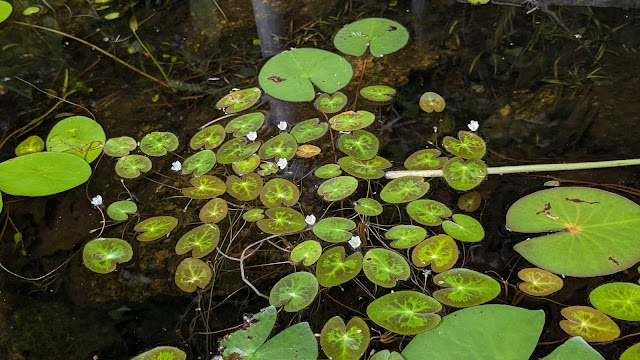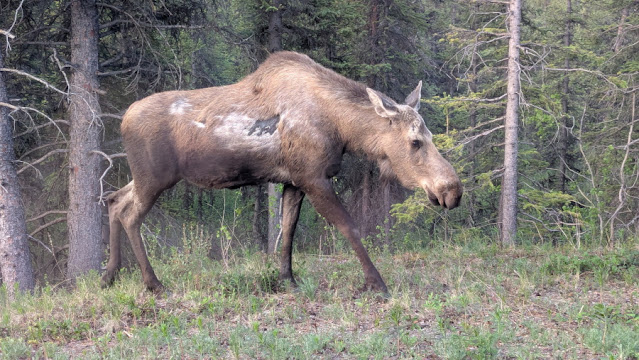No, not the kind of weed school we had in the 60's. This one was about aquatic plants, led by our own Russ Brummer, Science Department head at the New Hampton School.
 |
| Our fearless leader describes the Floating Bladderwort. |
A group of Wicwas Weedwatchers met on boats at the Wicwas launch where we first learned how to differential between native aquatic plants and the often similar looking non-native plants that can ruin a lake. Because non-native plants haven't been here for thousands of years they have no natural predators so they grow unrestrained and can completely overtake a waterbody.
The Lake Host program attempts to keep these invaders from moving from lake to lake, but we can't inspect every boat that comes in (more volunteers are always needed!) so the weed watcher team patrols the entire lake looking for dangerous weeds; if an outbreak does start we hope to catch it quickly.
We first looked at the notorious Eurasian Milfoil which is the bane of many lakes in New Hampshire.
 |
| Eurasian Milfoil |
We compared it to Coontail, a native plant often confused with milfoil.
 |
| Native Coontail |
It's hard to tell the difference, but milfoil has feathery-like leaves, while the coontail mostly has leaves with a single strand, looking like a pine needle. But if you're ever on a lake and see a plant that you think might be milfoil it's always better to report it - we're happy to determine it's not a problem, and it's great to have people watching for it.
After a short classroom session we hit the water for the real fun. With no known invasives in Wicwas - and none were found - we spent our time studying our native aquatic plants, many of which are both fascinating and beautiful. Last week I noted the Floating Bladderwort. This carnivorous plant floats freely in the lake, untethered to the bottom. The plant's bladders suck in water and tiny organisms such as insect larvae and water fleas, which the plant digests for sustenance. (Maybe they'll eat Spiny Water Fleas in lakes where that invasive species has arrived.) There are at least two other bladderwort species in Wicwas including the Common Bladderwort which can grow into huge floating mats and often concerns boaters due to its large size, but it is not a problem to the lake.
 |
| Large mats of Bladderwort can capture a lot of insect larvae and make great habit for small fish. |
As it grows and matures it can have huge submerged parts with hundreds of bladders that turn from pink to red to black as they consume their meals.
 |
| New pink growth on the left, more mature, black bladders on the right. |
Another native plant is the Floating Heart - a small lily pad with heart shaped leaves and a flower so tiny you really have to get close to appreciate its beauty.
 |
| Floating Heart |
 |
| The Bur-reed flower can look like it's associated with the surrounding lily pads. |
 |
| The blossom of the Watershield, a common native aquatic plant. |
We had a fun morning and we added to our lake knowledge - thank you Russ! If you're interested in becoming a Weed Watcher, here or on any other lake, check in with your lake association. They probably have a weed watching team, and if not, you can start one!
Back on dry land around the lake this week I came across a ground-nesting bird, the Veery. I flushed it from its nest on what is obviously a very little used trail, otherwise it wouldn't have built its nest just a few feet off the trail. I figured it was either a Veery or a Hermit Thrush. It wasn't hard to find the nest having seen where the bird came from - otherwise no one would ever know there was a nest hidden here.
 |
| A well hidden bird nest. |
But under that Bracken Fern was a tightly woven nest and four beautiful blue eggs.
The bright blue color tells me it's a Veery nest. Hermit thrush eggs have a lighter color and sometimes have brown spots. I quickly took a picture and left so mother veery could get right back to her eggs. I'll avoid that trail for a while.
Next I'll share a video sent to me by Conservation Commission volunteer Bob Hunt. His son took this video of what I believe is a litter of Fisher kits running across a driveway at Lake Winona. First at actual speed, then in slow motion.
The littlest sibling appears to be struggling to keep up! What a cool thing to have seen!
I would be remiss not to report on Spangle and Star, and happily, the reporter is that both are doing fine.
 |
| Mom or dad towers over the chicks, telling us to stay away. |
 |
| Star is still happy to hitch a ride on a parent's back. |
Birds, mammals, flowers, pretty lily pads - there's a lot to see around the lakes at this time of year. I hope you can get out to one the region's beautiful lakes to see some of nature's glory.














































